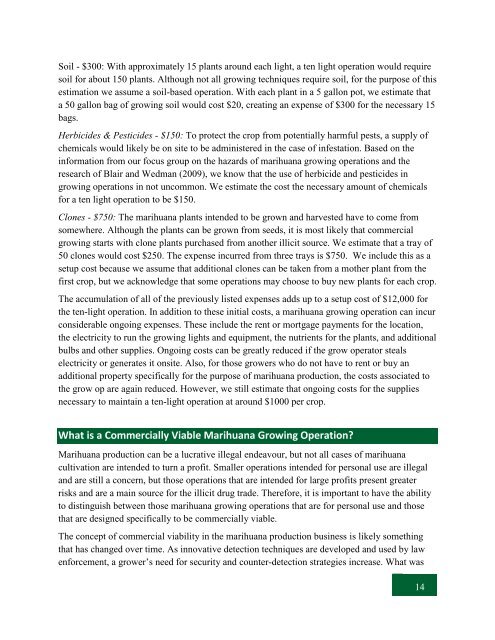Comercial+Grow+Op
Comercial+Grow+Op
Comercial+Grow+Op
Create successful ePaper yourself
Turn your PDF publications into a flip-book with our unique Google optimized e-Paper software.
Soil - $300: With approximately 15 plants around each light, a ten light operation would require<br />
soil for about 150 plants. Although not all growing techniques require soil, for the purpose of this<br />
estimation we assume a soil-based operation. With each plant in a 5 gallon pot, we estimate that<br />
a 50 gallon bag of growing soil would cost $20, creating an expense of $300 for the necessary 15<br />
bags.<br />
Herbicides & Pesticides - $150: To protect the crop from potentially harmful pests, a supply of<br />
chemicals would likely be on site to be administered in the case of infestation. Based on the<br />
information from our focus group on the hazards of marihuana growing operations and the<br />
research of Blair and Wedman (2009), we know that the use of herbicide and pesticides in<br />
growing operations in not uncommon. We estimate the cost the necessary amount of chemicals<br />
for a ten light operation to be $150.<br />
Clones - $750: The marihuana plants intended to be grown and harvested have to come from<br />
somewhere. Although the plants can be grown from seeds, it is most likely that commercial<br />
growing starts with clone plants purchased from another illicit source. We estimate that a tray of<br />
50 clones would cost $250. The expense incurred from three trays is $750. We include this as a<br />
setup cost because we assume that additional clones can be taken from a mother plant from the<br />
first crop, but we acknowledge that some operations may choose to buy new plants for each crop.<br />
The accumulation of all of the previously listed expenses adds up to a setup cost of $12,000 for<br />
the ten-light operation. In addition to these initial costs, a marihuana growing operation can incur<br />
considerable ongoing expenses. These include the rent or mortgage payments for the location,<br />
the electricity to run the growing lights and equipment, the nutrients for the plants, and additional<br />
bulbs and other supplies. Ongoing costs can be greatly reduced if the grow operator steals<br />
electricity or generates it onsite. Also, for those growers who do not have to rent or buy an<br />
additional property specifically for the purpose of marihuana production, the costs associated to<br />
the grow op are again reduced. However, we still estimate that ongoing costs for the supplies<br />
necessary to maintain a ten-light operation at around $1000 per crop.<br />
What is a Commercially Viable Marihuana Growing Operation?<br />
Marihuana production can be a lucrative illegal endeavour, but not all cases of marihuana<br />
cultivation are intended to turn a profit. Smaller operations intended for personal use are illegal<br />
and are still a concern, but those operations that are intended for large profits present greater<br />
risks and are a main source for the illicit drug trade. Therefore, it is important to have the ability<br />
to distinguish between those marihuana growing operations that are for personal use and those<br />
that are designed specifically to be commercially viable.<br />
The concept of commercial viability in the marihuana production business is likely something<br />
that has changed over time. As innovative detection techniques are developed and used by law<br />
enforcement, a grower’s need for security and counter-detection strategies increase. What was<br />
14


